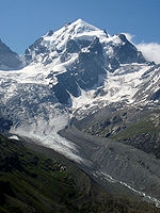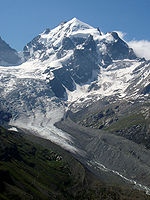
Adolphus Warburton Moore
Encyclopedia
Adolphus Warburton Moore (1841–1887) (known generally as A. W. Moore) was a British
civil servant and mountaineer
.
official from 1858–1887, holding the role of Assistant Secretary, Political Department from 1875–1885. He was also private secretary to Lord Randolph Churchill
.
in 1862 and immediately became a central figure in the golden age of alpinism
.
Moore's first ascents include:|event=Fiescherhorn
(Bernese Alps
) with H. B. George and the guides Christian Almer
and Ulrich Kaufmann}}|event=Barre des Écrins
(Dauphiné Alps
) with Edward Whymper
and Horace Walker
, and the guides Michel Croz
, Christian Almer
the elder, and Christian Almer the younger}}|event= Piz Roseg
Piz Roseg
(Bernina Alps) with Horace Walker and the guide Jakob Anderegg}}|event=Ober Gabelhorn
(Pennine Alps
) with Horace Walker and Jakob Anderegg}}|event=Pigne d'Arolla
(Pennine Alps
) with Horace Walker and Jakob Anderegg}}|event=Brenva Spur on Mont Blanc
with George Spencer Mathews, Frank Walker and Horace Walker, and the guides Jakob Anderegg and Melchior Anderegg
}}
This last route, the Brenva Spur, was the first to be climbed on the remote southern side of Mont Blanc
and exceeded in difficulty anything that had thus far been attempted on the mountain. Moore's description of the Brenva ascent is, according to Claire Engel, 'amongst the finest Alpine tales in existence'.
Moore went to the Caucasus
with Douglas Freshfield
and Charles Comyns Tucker in 1868, making the first ascent by a non-native of Mount Elbrus
(the lower of the two summits), the highest mountain in the Caucasus, and the first ascent of Kazbek with the same party.
gave the col its name during their first ascent of the Brenva face by the "Sentinelle Rouge" route in 1927, "The ordinary Brenva route [the Brenva Spur] begins with the ascent of a little gap, which we named Col Moore in honour of the first conqueror of the Brenva route, A. W. Moore, situated between the foot of the Brenva ridge and a miniature peak now known as the Pic Moore."
United Kingdom
The United Kingdom of Great Britain and Northern IrelandIn the United Kingdom and Dependencies, other languages have been officially recognised as legitimate autochthonous languages under the European Charter for Regional or Minority Languages...
civil servant and mountaineer
Mountaineering
Mountaineering or mountain climbing is the sport, hobby or profession of hiking, skiing, and climbing mountains. While mountaineering began as attempts to reach the highest point of unclimbed mountains it has branched into specialisations that address different aspects of the mountain and consists...
.
Life
The son of Major John Arthur Moore and Sophia Stewart Yates,, Moore was an India OfficeIndia Office
The India Office was a British government department created in 1858 to oversee the colonial administration of India, i.e. the modern-day nations of Bangladesh, Burma, India, and Pakistan, as well as territories in South-east and Central Asia, the Middle East, and parts of the east coast of Africa...
official from 1858–1887, holding the role of Assistant Secretary, Political Department from 1875–1885. He was also private secretary to Lord Randolph Churchill
Lord Randolph Churchill
Lord Randolph Henry Spencer-Churchill MP was a British statesman. He was the third son of the 7th Duke of Marlborough and his wife Lady Frances Anne Emily Vane , daughter of the 3rd Marquess of Londonderry...
.
Alpinism
Moore made a first ascent during his first visit to the AlpsAlps
The Alps is one of the great mountain range systems of Europe, stretching from Austria and Slovenia in the east through Italy, Switzerland, Liechtenstein and Germany to France in the west....
in 1862 and immediately became a central figure in the golden age of alpinism
Golden age of alpinism
The golden age of alpinism was the period between Alfred Wills's ascent of the Wetterhorn in 1854 and Edward Whymper's ascent of the Matterhorn in 1865, during which many major peaks in the Alps saw their first ascents....
.
Moore's first ascents include:|event=Fiescherhorn
Fiescherhorn
The Gross Fiescherhorn is a mountain in the Bernese Alps range of the Swiss Alps. At 4,049 metres above sea level, its summit culminates over the whole Fiescherhorn massif, which is also composed of the slightly lower Hinter Fiescherhorn and Klein Fiescherhorn...
(Bernese Alps
Bernese Alps
The Bernese Alps are a group of mountain ranges in the western part of the Alps, in Switzerland. Although the name suggests that they are located in the Bernese Oberland region of the canton of Bern, portions of the Bernese Alps are in the adjacent cantons of Valais, Lucerne, Obwalden, Fribourg and...
) with H. B. George and the guides Christian Almer
Christian Almer
thumb|220px|Christian AlmerChristian Almer was a Swiss mountain guide and the first ascentionist of many prominent mountains in the western Alps during the golden and silver ages of alpinism....
and Ulrich Kaufmann}}|event=Barre des Écrins
Barre des Écrins
The Barre des Écrins is a mountain in the French Alps, the highest point of the Massif des Écrins, and the most southerly alpine peak in Europe that is higher than 4,000 metres.- Geography :...
(Dauphiné Alps
Dauphiné Alps
The Dauphiné Alps are a group of mountain ranges in southeastern France, west of the main chain of the Alps. They are separated from the Cottian Alps in the east by the Col du Galibier and the upper Durance valley; from the western Graian Alps in the north-east by the river Arc; from the lower...
) with Edward Whymper
Edward Whymper
Edward Whymper , was an English illustrator, climber and explorer best known for the first ascent of the Matterhorn in 1865. On the descent four members of the party were killed.-Early life:...
and Horace Walker
Horace Walker
Horace Walker was an English mountaineer who made many notable first ascents, including Mount Elbrus and the Grandes Jorasses.-Alpinism:...
, and the guides Michel Croz
Michel Croz
Michel Auguste Croz was a French mountain guide and the first ascentionist of many mountains in the western Alps during the golden age of alpinism...
, Christian Almer
Christian Almer
thumb|220px|Christian AlmerChristian Almer was a Swiss mountain guide and the first ascentionist of many prominent mountains in the western Alps during the golden and silver ages of alpinism....
the elder, and Christian Almer the younger}}|event=

Piz Roseg
Piz Roseg is a mountain in the Bernina Range in Graubünden, Switzerland.There are two summits on its main ridge:*the south-east and higher summit *the north-west summit, known as the Schneekuppe ....
(Bernina Alps) with Horace Walker and the guide Jakob Anderegg}}|event=Ober Gabelhorn
Ober Gabelhorn
The Ober Gabelhorn is a mountain in the Pennine Alps in Switzerland, located between Zermatt and Zinal.-Geography:The Ober Gabelhorn lies in the Swiss canton of Valais at the southern end of the Zinal valley . It rises, together with the Dent Blanche and the Zinalrothorn , above the Zinal Glacier...
(Pennine Alps
Pennine Alps
The Pennine Alps are a mountain range in the western part of the Alps. They are located in Switzerland and Italy...
) with Horace Walker and Jakob Anderegg}}|event=Pigne d'Arolla
Pigne d'Arolla
Pigne d'Arolla is a mountain in the Pennine Alps in Switzerland.The first ascent was made by A. W. Moore and Horace Walker with the guide Jakob Anderegg on 9 July 1865.-External links:*...
(Pennine Alps
Pennine Alps
The Pennine Alps are a mountain range in the western part of the Alps. They are located in Switzerland and Italy...
) with Horace Walker and Jakob Anderegg}}|event=Brenva Spur on Mont Blanc
Mont Blanc
Mont Blanc or Monte Bianco , meaning "White Mountain", is the highest mountain in the Alps, Western Europe and the European Union. It rises above sea level and is ranked 11th in the world in topographic prominence...
with George Spencer Mathews, Frank Walker and Horace Walker, and the guides Jakob Anderegg and Melchior Anderegg
Melchior Anderegg
Melchior Anderegg , from Zaun, Meiringen, was a Swiss mountain guide and the first ascensionist of many prominent mountains in the western Alps during the golden and silver ages of alpinism...
}}
This last route, the Brenva Spur, was the first to be climbed on the remote southern side of Mont Blanc
Mont Blanc
Mont Blanc or Monte Bianco , meaning "White Mountain", is the highest mountain in the Alps, Western Europe and the European Union. It rises above sea level and is ranked 11th in the world in topographic prominence...
and exceeded in difficulty anything that had thus far been attempted on the mountain. Moore's description of the Brenva ascent is, according to Claire Engel, 'amongst the finest Alpine tales in existence'.
Moore went to the Caucasus
Caucasus
The Caucasus, also Caucas or Caucasia , is a geopolitical region at the border of Europe and Asia, and situated between the Black and the Caspian sea...
with Douglas Freshfield
Douglas Freshfield
Douglas William Freshfield was a British lawyer, mountaineer and author, who edited the Alpine Journal from 1872 to 1880...
and Charles Comyns Tucker in 1868, making the first ascent by a non-native of Mount Elbrus
Mount Elbrus
Mount Elbrus is an inactive volcano located in the western Caucasus mountain range, in Kabardino-Balkaria and Karachay-Cherkessia, Russia, near the border of Georgia. Mt. Elbrus's peak is the highest in the Caucasus, in Russia...
(the lower of the two summits), the highest mountain in the Caucasus, and the first ascent of Kazbek with the same party.
Commemoration
Both Pic Moore and Col Moore on the Brenva face side of Mont Blanc are named after him. According to F. S. Smythe, who together with Thomas Graham BrownThomas Graham Brown
Thomas Graham Brown FRS was a Scottish mountaineer and physiologist.-Life and family:Graham Brown was born in Edinburgh 1882; his father – Dr J. J. Graham Brown – was a President of the Royal College of Physicians in Edinburgh. T...
gave the col its name during their first ascent of the Brenva face by the "Sentinelle Rouge" route in 1927, "The ordinary Brenva route [the Brenva Spur] begins with the ascent of a little gap, which we named Col Moore in honour of the first conqueror of the Brenva route, A. W. Moore, situated between the foot of the Brenva ridge and a miniature peak now known as the Pic Moore."

